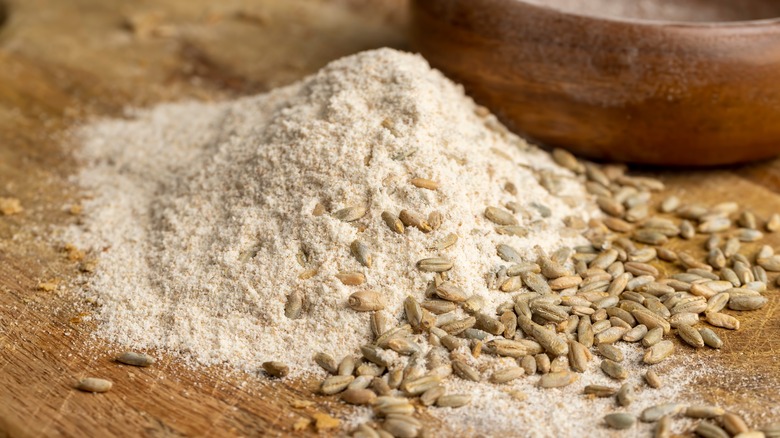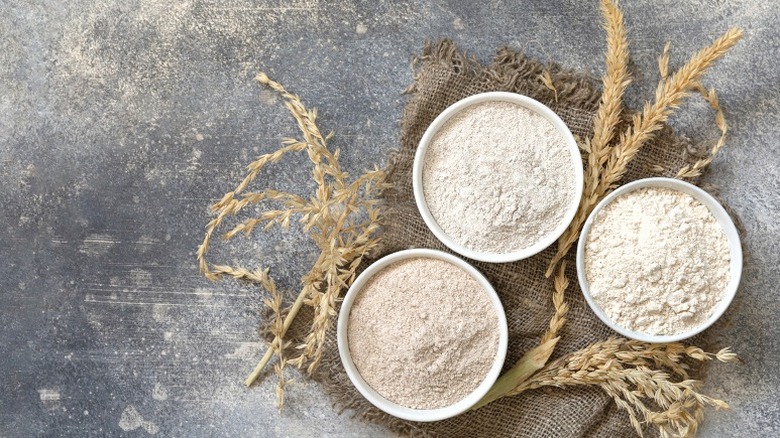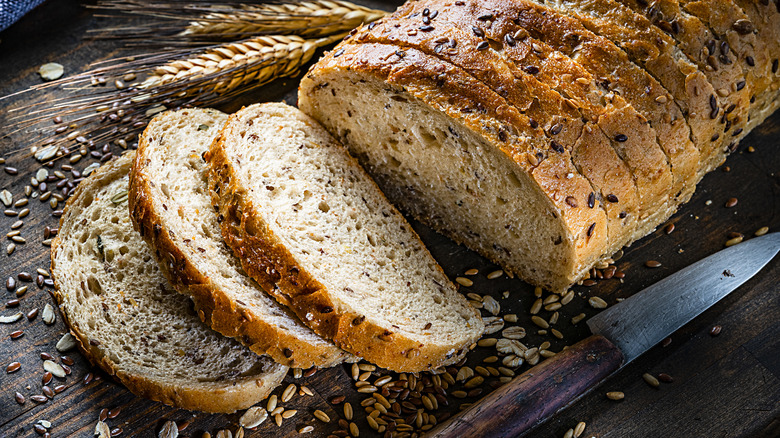How Spelt Flour Differs From Its All-Purpose Counterpart
Take a stroll down a grocery store's baking aisle, and you might be surprised at the wide variety of flour, beyond the standard all-purpose. Some types are self-explanatory: Cake and bread flour are for specific recipes, while rice, oat, and barley flour are made from their namesake grains. But what about the mysterious spelt flour? This special product is part of a world of underrated flours, which offer unique nutritional, textural, and flavor-based advantages.
Spelt is an ancient variety of wheat from the Middle East, and historians believe it was first cultivated more than 9,000 years ago. A relative of chewy, nutty farro, spelt is typically ground in whole form, without the bran or germ removed. All-purpose flour is made of 100% wheat, too, but uses a combination of hard and soft wheat varieties. It includes only the endosperm of the grain, discarding the fibrous outer layer and nutrient-dense germ (if you leave these parts in, you'd wind up with whole wheat flour). However, more processed "white spelt" flours, which only use the endosperm, are also available.
Due to these traits, spelt and AP flours wind up with separate nutritional profiles and behave a little differently in baking recipes. However, they're quite similar overall — spelt can be seen as just another type of whole wheat flour. Spelt and all-purpose flour can be used almost interchangeably, but spelt tastes a bit different, and needs to be handled more gently overall.
Flavor and nutritional distinctions between spelt and all-purpose flour
Although less dramatically different from all-purpose flour than some other options on the market, spelt flour has some unique qualities to keep in mind. Firstly, its nutrition content is different. Because the entire grain is used when making this flour, all of the spelt's nutrients are included in the finished product. Compared to AP flour, spelt flour is naturally higher in nutrients like iron, zinc, and niacin, and is a great source of protein and fiber.
However, spelt flour should never be confused with gluten-free alternative flours, like rice or almond. While spelt is lower in FODMAPs and gluten than conventional breeds of wheat, it will still trigger gastrointestinal symptoms in folks with Celiac disease and gluten sensitivities.
As for the difference in flavor, spelt has its own unique taste. All-purpose flour can develop a different flavor based on where it's grown, when it's harvested, and the specific wheat species used to make it. However, it's generally considered to be neutral in taste. When switching to spelt, bakers notice a distinct nuttiness, subtle sweetness, and even a touch of tanginess. None of these flavors are so strong as to overpower a recipe, but you might pick up on these pleasant notes in your cakes, breads, and other goods. Spelt flour's texture, meanwhile, has a bigger impact on your recipes.
Using and storing spelt flour
When making whole wheat bread or baked goods, a number of things can go wrong. You might be tempted to make whole wheat versions of your favorite recipes to give them a nutritional boost, but this kind of flour often produces drier, denser baked goods. Spelt flour, on the other hand, produces results more similar to those of all-purpose flour, and isn't likely to give you any problems with texture. It can be swapped for all-purpose at a 1:1 ratio, without the many modifications whole wheat flour requires, while stilling offering more nutrients.
The one catch is that spelt flour forms more delicate gluten strands compared to AP flour, and requires more careful handling to produce the best results. It's easier to overwork spelt flour, which will create crumbly baked goods, rather than the soft, squishy texture we're usually aiming for. Spelt flour also absorbs water less readily. This means you might not need as much liquid or other moist ingredients in your dough or batter to arrive at the desired consistency. Add liquid ingredients slowly, lest you end up with soggy results.
Lastly, since spelt flour contains the full wheat berry — and most brands use fewer added preservatives — it should be refrigerated to keep it from spoiling prematurely. The same rule applies for any whole-grain flour, which all tend to go bad more quickly than the more processed white flour.



